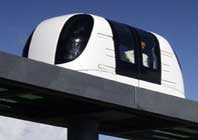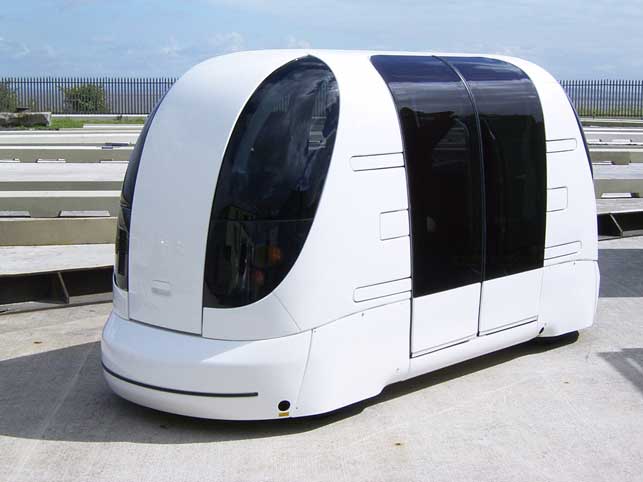Driverless vehicles that effortlessly deliver passengers in futuristic automatically guided luxury pods may be the stuff of science fiction, but they will soon become a reality when they are unveiled to the public at London’s Heathrow Airport later this year. The ULTra Personal Rapid Transportation (PRT) programme is the first project of its kind and heralds a new era in transportation.
With its aluminium chassis, air conditioning, LED screens displaying journey information, and cameras the Heathrow ULTras are well equipped, sleek and appealing. Smart scheduling reduces waste in use by optimising journey routes while onboard systems compensate for wind, obstacles and other obstructions that might be encountered.

400 of these vehicles are to serve all terminals at Heathrow Airport
The driverless vehicles run on a dedicated lightweight guideway, the cost of which is relatively low compared to roadways and light rail, as is their cost of installation. Operational costs are also low since there are no drivers, and the environmental benefits are significant with zero emissions at the point of use and no empty busses needlessly cruising around.
The company responsible for design engineering and production of the vehicles is ARRK R+D, based in Basildon. Jason Roberts, ARRK Director, provides the details. “This project includes development of 21 initial vehicles that will run on a dedicated track much of which is elevated. This was fitted on site at Heathrow at up to 80m per night and will carry passengers to their destination at up to 40km/h.”
The first 21 vehicles are for Terminal 5. However, it is planned to eventually have 400 vehicles running at Heathrow serving all terminals. Despite this level of service, the economics of this type of transport system are very promising and the entire Heathrow project will cost around €30m including vehicles.
From digital prototyping to testing, ARRK relied on a single system for the development of the ULTra. “Our work was carried out using the Dassault Systèmes’ V5 PLM suite,” explains Jason. “This delivered the advantages that we experience in our other work, which includes the benefit of operating on a single software platform for prototyping, tooling, testing and surfacing. Suspension durability testing was carried out using Abaqus and the software helped to provide the vehicles with their highly accurate tracking characteristics.”
“We cut tooling direct from 3D Catia models and can easily accept third party software input from stylists and others in the supply chain, incorporating it to develop 3D data for our purposes,” adds Phil Griffiths, General Manager, Engineering Group.
Future vision
ARRK sees a strong future for ULTra with interest coming from around the world including Middle Eastern cities, leisure resort hotels and other mixed usage environments that would replace bus services or conventional transport with this modern alternative system. When this happens the company is ready to react. “Our technological position means that we are the data holder for the ULTra project and since we have more than 300 seats of V5 PLM within Europe alone, we will be able to deal with any level of demand,” concludes Phil Griffiths.
www.arrk.eu / www.3ds.com/ukisa
Dassault’s V5 PLM drives future of personal transport at London’s Heathrow Airport






